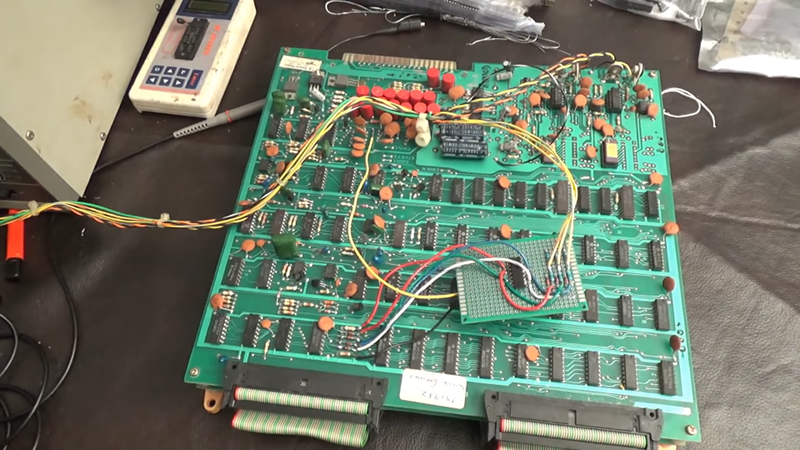Asteroids is one of the classic games of the early arcade era. Launched in 1979 by Atari, it relied upon using an XY vector monitor to deliver crisp graphics for its space-based gameplay. One of the limitations of the original arcade games was that the game was only rendered in a single colour, white. Over 30 years later, [Arcade Jason] decided to see what it would take to build a color Asteroids machine.

The hack relies on the fact that the original game used a four-bit resistor ladder DAC to draw vectors in different intensity levels. Through some ingeniously simple hardware, this DAC is repurposed to denote different colours instead. It’s laced together with a 74LS08 AND gate chip, along with a handful of resistors and diodes. Three bits are used for red, green, and blue, respectively, with the fourth used as a “white boost” signal to allow the differentiation of colours like red and pink, or dark and light blue. It’s then all wired into an RGB vector monitor for final display. After that, it’s just a matter of a simple ROM hack to set the colors of various on screen objects.
Vector monitors are notoriously hard to film well, but it’s clear that in person the output is rather impressive. Making color versions of old retro games is actually a hobby of [Arcade Jason]’s – we’ve featured his color Vectrex before. Video after the break.

















… but (R AND (R OR G OR B OR W)) is identical to R …?
I’d be tempted to replace the original resistor ladder with a ROMDAC. Since using only the SCALEn outputs would dramatically underuse any ROM at all, maybe one could use DACXn* and DACYn* signals to change color depending where on the screen the vector is, or maybe the ADMAn signals to select based on where in the display list…
yes but with the rom hack the color of each vector can be programmed rather than random
Sure? The romhack means that you can choose an arbitrary intensity = arbitrary color for each line, but if you replace the RGBI DAC you’ve implemented with something that uses a ROM as a hardware palette you can get even more breadth of colors.
What sort of rate do the old vector video games display vectors? It couldn’t have been all that fast – the hardware driving them was only a MHz or so, and they needed high-persistence phosphors for applications with “lots” of vectors.
I mean, the bigger problem is the vector displays and even CRTs in general are rapidly disappearing. It seems like it should be possible to take a modern CPU (RPi?) and “moderate speed” A2D converter, and build an X-Y to HDMI converter. I realize that modern digital scope sort of do this, with rather poor results, but I doubt that they have code optimized for “display” applications.
any tv set on the curb can be converted to a vector monitor the problem is not lack of parts its lack of know how and interest . i have videos on my channel showing tv to vector conversions i would much rather preserve a machine than convert it to something else. by the way the vector to raster conversion device you speak of has already been invented its called vector to vga tempest (vga can be converted to hdmi)
Well there are *some* difficulties in taking a TV set and making it into a vector monitor. First, the vertical yoke would have to be changed, since it is designed to operate at relatively low frequencies – like 50-60Hz. Second, the EHT for the tube has to come from a new supply, since EHT in a regular CRT monitor is generated by the line output transformer flyback pulse. And last, you’d have to make some amplifiers to convert the X and Y inputs to a current for the deflection coils. I imagine that there would be some fun with some tube geometries as well, especially related to convergence.
there are simple solutions for all of this i have a video which shows you how to rewind your yoke and a video that shows how trick your tv to produce hv even when there is no yoke present. The deflection circuit is very simple to build your self or you can buy a new kit also there is no geometry issues as long as you use the same yoke that came with the tube. A yoke never needs to be removed to be rewound so convergence stays at its factory settings and displays a perfect picture.
Hi Jason
Great work
I did a search for your yoke rewinding video but nothing obvious turning up – would you be able to share the link?
Many thanks
@Alexander 85 Judd:
How to wind a vector yoke
https://www.youtube.com/watch?v=Ci9qiGVMF7s
Arcade Jason has a lot of great arcade tech vids, especially vector stuff. https://www.youtube.com/channel/UCODLTJtRV-jYvmTx9YScCVQ/videos
Set world’s record on Asteroids in 1981, playing for over 2 days on a quarter. You can find an article I wrote about the record, The Summer of 81, on my LinkedIn page. Message me and I will share Atari official high score certificate
https://www.linkedin.com/in/mark-branson-9bb0848b
We had oh so much fun at PB Wizards !